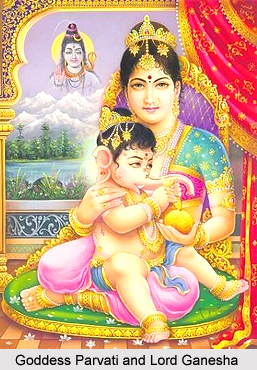 The Legend of Lord Ganesha and Parvati teaches the lesson that all living creatures should be respected as they are of divine essence. The legends of Lord Ganesha are mostly depicted in the Puranas and other Hindu religious texts. Lord Ganesha (Ekadanta) is the son of Lord Shiva and Goddess Uma (Parvati) and the brother of Lord Kartikeya. The various Mahapuranas and the Upapuranas, such as Ganesha Purana, Shiva Purana, Mudgala Purana and Brahmavaivarta Purana describe several tales of the deity that and that depicts his nature and character.
The Legend of Lord Ganesha and Parvati teaches the lesson that all living creatures should be respected as they are of divine essence. The legends of Lord Ganesha are mostly depicted in the Puranas and other Hindu religious texts. Lord Ganesha (Ekadanta) is the son of Lord Shiva and Goddess Uma (Parvati) and the brother of Lord Kartikeya. The various Mahapuranas and the Upapuranas, such as Ganesha Purana, Shiva Purana, Mudgala Purana and Brahmavaivarta Purana describe several tales of the deity that and that depicts his nature and character.
This particular legend states that once Lord Ganesha, during his childhood, was playing with a cat and was tormenting it pulling the cat`s tail. Moreover, Bala Ganesha forcefully rolled the cat on the ground and refused to let it go until he was done playing with it. After some time the lord released the cat from its agony and it went away peacefully. The noble child did not even realize that he had committed a sin by hurting the animal.
Later when Lord Ganesha went back to his home at Mount Kailash, he met with his mother Goddess Parvati (Uma). But the goddess was severely injured and had wounds all over her body. She was suffering badly and was covered with dust. Ganesha became astounded and asked her how she got injured. Goddess Parvati replied that Ganesha was responsible for her wounds and suffering. Parvati had taken the form of the divine cat, which was tortured and tormented by child Ganesha.
The message of this legend is that all living beings should be respected equally and hurting an innocent creature, animal or human, is equivalent to hurting God.
This article is a stub. You may enrich it by adding more information to it. You can send your write-up at content@indianetzone.com




















